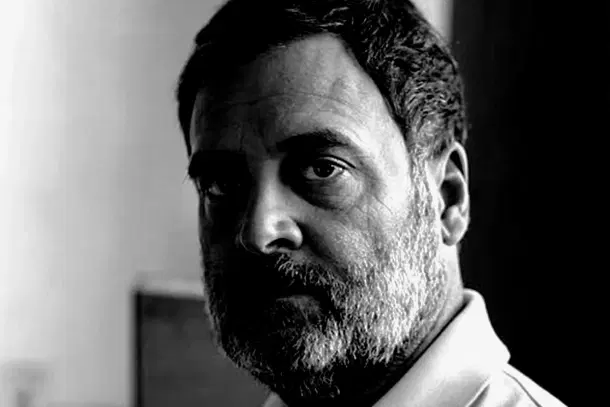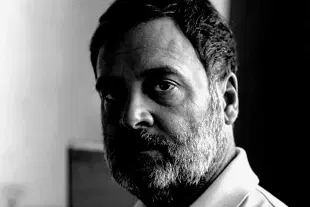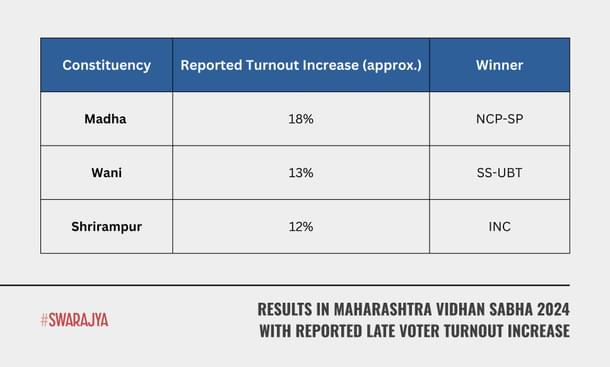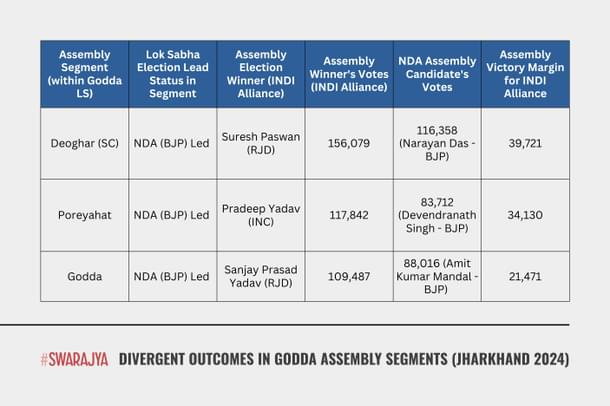Politics
Rahul Gandhi’s Chronic Fixation With Match-Fixing Betrays His Desperation: Here's A Step-Wise Rebuttal
Shivansh Mishra and Naga Praneeth Kalisetty
Jun 09, 2025, 02:41 PM | Updated 02:50 PM IST
Save & read from anywhere!
Bookmark stories for easy access on any device or the Swarajya app.


More than 7 months after the conclusion of the Maharashtra Assembly Elections, Rahul Gandhi interestingly chose to publish an article alleging widespread voter fraud by the BJP Government in support of its Mahayuti allies with the oversight (or alleged lack thereof) of the Election Commission of India (ECI).
Interestingly, the Congress party raised similar claims in November 2024, which were comprehensively addressed by the ECI in a 66-page rebuttal. Fundamentally, the questions and claims posed then and now are the same. This begs the question — why bring up an issue that has already been addressed?
Although only Gandhi himself would be able to answer that, one may speculate that these are not the best of times for the Congress. Decisions taken by the BJP with regard to domains ranging from national security (Operation Sindoor) to social justice (2027 caste census) have left little room for criticism by the Opposition, least of all criticism that is based in truth.
As the article will elucidate below, Gandhi’s article is, at best, a desperate attempt to arouse voter dissatisfaction with the alleged lack of integrity of the BJP and, at worst, a blatant distortion of facts and data to conjure a sensationalist piece.
Recent Shortcomings & Irrelevance of INC
As the designated Leader of Opposition in Parliament, perhaps it is Rahul Gandhi’s obligation to question the central government as part of an honest and spirited discharge of his duties. One may even commend the spirited nature of the article and call for democracy to be upheld in the face of a ‘dictatorial’ Prime Minister.
However, with a 75% approval rating, which can only be thought to have increased in recent months given the success of Operation Sindoor, Rahul Gandhi’s claims are hollow.
With few avenues left for the Opposition to criticise the Centre, there is room only for desperate measures such as Gandhi’s.
The timing of the release of the article is convenient as a ruse to cover up and save face. Given that the ED has publicly acknowledged a ‘prima facie’ case has been constituted against Sonia Gandhi and Rahul Gandhi, it is the perfect time for a smokescreen to be cast in the form of questioning the integrity of the government and institutions.
The desperation of the Congress is best illustrated by its leaders’ responses in the aftermath of the Pahalgam terror attack and Operation Sindoor. In light of the attack, numerous Congress leaders made remarks criticising the government for a lack of security provided to tourists, with some even questioning the communal nature of the attack, publicly stating that tourists were not killed for being non-Muslims.
The fact that there was a disregard for the swift and decisive response of the Indian government shows that the Congress has a habit of clutching at straws to find dirt on the centre. Successfully thwarting Pakistani attempts to inflict damage through drone strikes was a testament not only to the resilience of the armed forces but the foresight of the Government in developing robust air defense measures.
Further, Shashi Tharoor, one of the most popular and senior Congress politicians, has publicly praised the centre’s response, which is clear evidence of the unifying nature of Op Sindoor. A seniormost leader going against party rhetoric is definitely not a good look for the party. Perhaps a Congress Jodo Abhiyan is the need of the hour for the party.
Reports of infighting among the leadership of the party in Karnataka are further indicative of this need. The infighting, coupled with ineffective governance, has seriously hampered the party’s reputation.
Having recently completed two years of being in power in the state, a total of ₹80,000 crore has been spent on distributory welfare problems, which has arguably contributed to a hike in prices of essential commodities like fuel, electricity, water, and milk. Multiple scams and allegations of a ‘commission rate’ in excess of 40% by the Karnataka State Contractors Association are emblematic of typical Congress governance
Finally, a longstanding demand of the Congress and its allies finally became reality when the Modi Government announced the caste census to be conducted in 2027. An issue that was consistently raised by Congress as part of its 'jitni aabaadi, utna haq' campaign was finally put to rest, leaving the party desperate for new issues to criticise the centre on, even if it means digging up ones that have been settled.
How To Craft A Sensationalist, Baseless Story a la Rahul Gandhi
Let us break down the arguments made by Rahul Gandhi step-by-step, in the manner in which he presented them. Instead of uncovering a mastermind plot to rig an election, Gandhi has provided a playbook on how to raise an alarmist narrative as a desperate measure through his article.
Step 1: Rig the Panel for the Appointment of Umpires – Employ an Ultra-Selective Memory and Showcase Ignorance of Guidelines Laid Down by the Constitution
For someone who has spread fear-mongering claims about the BJP’s aim of altering the Constitution beyond recognition, Rahul Gandhi displays little in-depth knowledge of its provisions.
Gandhi’s allegation that the CJI’s removal from the selection panel for Election Commissioners is ‘biased’ simply overlooks historical precedent and constitutional guidelines. The Election Commissioners Appointment Act 2023 lays provides for a committee of three individuals — Prime Minister, Home Minister, and Leader of Opposition — to appoint Election Commissioners. In fact, the inclusion of the Leader of Opposition is a step towards broader consultation, which wasn't consistently followed under previous governments.
While the Act replaced the CJI with a Union Cabinet Minister, the formal inclusion of the Opposition Leader represents a more consultative mechanism than past unilateral appointments. The Supreme Court had directed Parliament to create a legislative framework, which the 2023 Act provides. This initial claim seems a strategic attempt to cast doubt over the entire electoral process.
25 out of 26 Chief Election Commissioners' appointments till date have been carried out unilaterally by the central Government, with most of them coming under Congress rule. If the current mechanism is "rigging," then such practices, common for over six decades, would be evidence to label the past elections under Congress regimes as "rigged".
Step 2: Inflate the voter register with fake voters – Misrepresent Growth and Data Trends to Support Your Narrative
Rahul Gandhi claims an “incredible leap” of 41 lakh voters in Maharashtra between the May 2024 Lok Sabha and November 2024 Vidhan Sabha elections. He suggested that due to this inflation based on “fake voters”, the registered voter total of 9.70 crore surpassed adult population estimates of 9.54 crore. However, this assertion weakens when contextualised.
A significant portion of this increase is attributable to new young voters, with over 26 lakh young voters joining the rolls out of the approximately 41 lakh new additions. This reflects successful youth inclusion, not manipulation. The Election Commission had noted this as a "welcome trend in the participation of the youth," a point Rahul Gandhi appears to confuse with turnout figures.
Historical data on voter roll expansion in Maharashtra shows substantial increases in previous five-year periods: 63 lakh between 2014-2019, 75 lakh between 2009-2014, and 1 crore between 2004-2009, suggesting the 2024 increase was not extraordinary.
A comparison of voter increases between Lok Sabha and subsequent Vidhan Sabha elections in the same year in Maharashtra also provides context:
The 4% increase in 2024 aligns with historical trends (such as 4% in 2009, 5% in 2004). The Election Commission had reportedly addressed these concerns in a detailed communication to the INC in December 2024. The “fake voters” narrative misrepresents natural demographic growth and successful registration drives.
Step 3: Inflate voter turnout figures on top of an inflated voter base – Misinterpret Standard Processes to Plant Seeds of Doubt
Rahul Gandhi alleges that after polling officially closed at 5 PM, the "turnout kept increasing," with the final figure showing a 7.83 percentage point increase over the 5 pm provisional figure of 58.22%, implying manipulation.
This claim reveals Gandhi’s poor understanding of standard electoral procedures. All voters who have joined the queue before the official voting closing time of 5 pm are permitted to cast their vote. As such it is normal for turnout to increase after 5 pm, given the average hourly polling rate (around 5.83% per hour for the Maharashtra 2024 Assembly polls).
The ECI releases both provisional turnout figures based on votes polled up till 5 pm as well as final official turnout after all polling concludes and Form 17C (recording votes polled per booth) is scrutinized from every station. Hence, the increase is an accurate accounting, not “inflation”.
To highlight the normalcy of this phenomenon, a pertinent comparison can be made:
A comparable increase of 5.75 percentage points occurred during Phase II of the 2024 Lok Sabha elections. This reflects Rahul Gandhi's selective focus on such increases only when election outcomes are unfavorable.
The ECI's press release for Maharashtra 2024 indicated a 5 pm turnout of 58.22%, with final turnout reported significantly higher, around 65.02% by some media, aligning with the 66.05% figure Rahul Gandhi uses.
More critically, the claim that such turnout increases invariably benefits one alliance is refuted by counter examples. For instance, in Madha, with an 18% increase, the NCP's (SP) candidate won; in Wani, with a 13% increase, the Shiv Sena’s (UBT) candidate won; and in Shrirampur, with a 12% increase, the Congress candidate was victorious.

Step 4: Pinpoint targeted bogus voting turned BJP into Bradman – Cherry-pick Data and Ignore Facts which do not Align with your Narrative
Rahul Gandhi alleges that increased voters and turnouts were concentrated in 12,000 booths across 85 BJP-poorly-performing Lok Sabha constituencies, leading to NDA wins using targeted bogus voting. He cites the example of Kamthi where Congress' vote share was stable while BJP's jumped, attributing this to new voters.
However, citing Kamthi as an example represents an acute misunderstanding of voter behaviour and electoral dynamics.
In the Lok Sabha election for the Ramtek seat (under which Kamthi falls), the candidate fielded by the Mahayuti, Raju Deonath Parve, was a former Congress man who had switched allegiances to first the BJP and then the Shiv Sena. Although it can be debated whether this truly had an effect on voters, the willful omission of this fact in Gandhi’s article is further telling of his desperation to create something out of nothing.
On the other hand, in the Assembly election for the Kamthi seat, the BJP state president, Chandrasekhar Bawankule, was fielded as the candidate. Bawankule’s popularity, evidenced by his election from Kamthi three times (2004, 2009, 2014) on a BJP ticket definitely played a role in increased voter turnout. This, too, was ignored by Gandhi in his article.
Further, Gandhi fails to consider the effect of Mahayuti’s Ladki Bahin Yojana behind increased voter turnout. Women’s turnout increased by 6% between the assembly and general elections, a fact ignored by Gandhi’s shallowly researched article.
Regarding the mechanics of late voting, calculations based on the day's average voting rate suggest that the votes cast after the provisional cut-off would have required a much shorter additional time per booth than speculated by Rahul Gandhi.
The flaw in the Kamthi example is further exposed by electoral shifts in Jharkhand between the 2024 General and Assembly elections.
Within the Godda Lok Sabha constituency, won by the NDA, several assembly segments where the BJP led during the national polls saw decisive victories for the INDI alliance just months later in the state election.

If one were to apply Rahul Gandhi's own logic, these significant shifts away from the NDA would imply a massive, targeted manipulation by the opposition, a conclusion that reveals the absurdity of his premise. The reality is that voters frequently make different choices in national versus state elections.
Rahul Gandhi's argument is a classic case of confirmation bias, selecting one convenient example while ignoring all data that contradicts it.
The fact that opposition parties won in constituencies with similar or larger turnout increases (as in Maharashtra) or where significant voter preference swung between elections (as in Jharkhand) discredits the notion of a systemic manipulation benefiting only one party.
Electoral outcomes are multifaceted, driven by local issues, candidate appeal, and campaign dynamics, not the simplistic conspiratorial fantasies cooked using selective evidence.
Step 5: Conceal the evidence trail – Make Senseless Requests to Authority whose fulfilment would undermine protocol
Rahul Gandhi alleges that the ECI has met Opposition queries with “silence and even aggression,” dismissing requests for voter rolls with photos. Further, he accuses the central government of collusion with the ECI to amend Section 93(2)(a) of the Conduct of Election Rules, 1961, in order to restrict access to CCTV footage and electronic records.
However, Gandhi fails to acknowledge that the ECI is still expected to address legitimate concerns transparently. Section 93(2)(a) was amended in December 2024, specifying that only those election-related papers “as specified in these Rules” are open to public inspection. This could restrict general public access to certain documents not explicitly listed.
A crucial detail omitted by Gandhi in his article is that “candidates retain access to all election records, including electronic materials”. This ensures those directly involved can verify processes or pursue legal challenges. As such, the “concealment of evidence” narrative is baseless. The amendment's stated purpose was to “curb misinformation and prevent the misuse of electoral information,” and protect voter privacy.
Gandhi further claims that the Congress’ request for voter rolls with photos of each voter was denied by the ECI. However, given that existing processes provide for each candidate's polling agent to acquire a copy of the electoral roll for their station, with the right to challenge voter identity, the public dissemination of photo-affixed rolls is unnecessary and violates voter privacy guidelines laid down by the ECI. The portrayal of the rule amendment as a deliberate cover-up is misleading, as candidate access for accountability still remains.
Symptom of broader disarray
Rahul Gandhi’s opinion piece on the Maharashtra elections reflects a deeper crisis within the Congress party rather than a credible challenge to electoral processes. Far from sparking a meaningful debate, it reveals a leadership out of touch with both its electorate and its own rank-and-file.
The Congress, once a dominant force, now flounders under the weight of inconsistent messaging and a failure to adapt to India’s shifting political currents. Gandhi’s claims, lacking substance, do little to mask this reality.
The piece’s timing, long after the polls and amid unrelated controversies, hints at a party more focused on headlines than on rebuilding trust among voters. This isn’t just about one article; it’s a symptom of broader disarray. The Congress struggles to articulate a vision that resonates, ceding ground to a ruling government that commands both narrative and action. While the opposition flails, the electorate watches a party unable to reconcile its past glories with its present predicaments.
For the Congress to regain relevance, it must move beyond reactive rhetoric and address its internal fractures head-on. Gandhi’s intervention, meant to rally support, instead highlights a disconnect—a leadership adrift, leaning on accusations rather than offering solutions. Until the party confronts these systemic weaknesses, such efforts will remain footnotes in a political story increasingly written by others.
Shivansh Mishra writes on law, governance, and politics.He brings a grounded perspective shaped by close engagement with legal research and political processes. Naga Praneeth Kalisetty is a management student at IIM Indore with a keen interest in geopolitics and world affairs.





